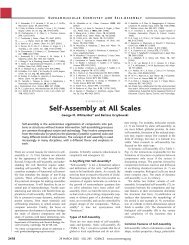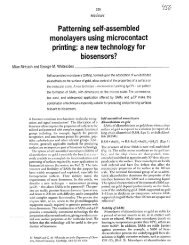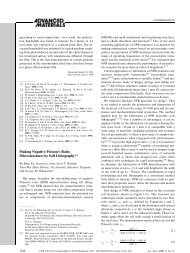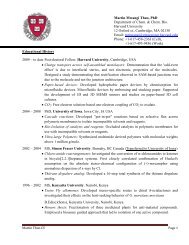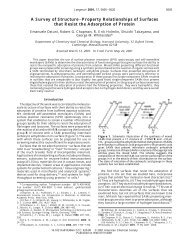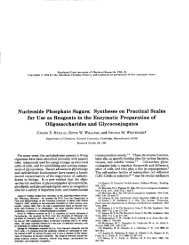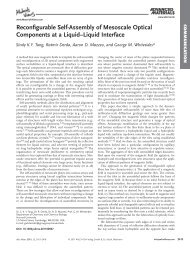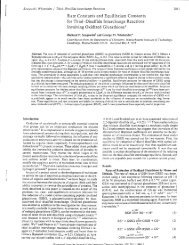Self-Assembled Monolayers of Thiolates on Metals as - Whitesides ...
Self-Assembled Monolayers of Thiolates on Metals as - Whitesides ...
Self-Assembled Monolayers of Thiolates on Metals as - Whitesides ...
Create successful ePaper yourself
Turn your PDF publications into a flip-book with our unique Google optimized e-Paper software.
1116 Chemical Reviews, 2005, Vol. 105, No. 4 Love et al.<br />
Figure 3. Schematic diagram depicting the arrangement<br />
<str<strong>on</strong>g>of</str<strong>on</strong>g> decanethiolates <strong>on</strong> Au(111) lattice when maximum<br />
coverage <str<strong>on</strong>g>of</str<strong>on</strong>g> the thiolates is attained. (a) Structural model<br />
<str<strong>on</strong>g>of</str<strong>on</strong>g> the commensurate adlayer formed by thiols <strong>on</strong> the gold<br />
lattice. The arrangement shown is a (�3×�3)R30° structure<br />
where the sulfur atoms (dark gray circles) are positi<strong>on</strong>ed<br />
in the 3-fold hollows <str<strong>on</strong>g>of</str<strong>on</strong>g> the gold lattice (white circles,<br />
a ) 2.88 Å). The light gray circles with the d<strong>as</strong>hed lines<br />
indicate the approximate projected surface area occupied<br />
by each alkane chain; the dark wedges indicate the<br />
projecti<strong>on</strong> <str<strong>on</strong>g>of</str<strong>on</strong>g> the CCC plane <str<strong>on</strong>g>of</str<strong>on</strong>g> the alkane chain <strong>on</strong>to the<br />
surface. Note the alternating orientati<strong>on</strong> <str<strong>on</strong>g>of</str<strong>on</strong>g> the alkane<br />
chains defines a c(4 × 2) superlattice structure. The formal<br />
c(4 × 2) unit cell is marked (l<strong>on</strong>g d<strong>as</strong>hes); an equivalent<br />
2�3 × 3 unit cell is marked by lines with short d<strong>as</strong>hes.<br />
The alkane chains tilt in the directi<strong>on</strong> <str<strong>on</strong>g>of</str<strong>on</strong>g> their next-nearest<br />
neighbors. (b) Cross-secti<strong>on</strong> <str<strong>on</strong>g>of</str<strong>on</strong>g> the SAM formed from<br />
decanethiol. Note the alternating rotati<strong>on</strong>s <str<strong>on</strong>g>of</str<strong>on</strong>g> the carb<strong>on</strong><br />
chains in this view. The chains are labeled with twist<br />
values (�) to indicate the relative orientati<strong>on</strong>s <str<strong>on</strong>g>of</str<strong>on</strong>g> the<br />
neighboring chains.<br />
<str<strong>on</strong>g>of</str<strong>on</strong>g> the chains corresp<strong>on</strong>ding to a c(4 × 2) superlattice.<br />
270,271 Figure 3a shows this structure schematically.<br />
The SAMs formed by n-alkanethiols were<br />
originally described <strong>as</strong> thiolate overlayers (chemisorbed<br />
structures formed by the activati<strong>on</strong> <str<strong>on</strong>g>of</str<strong>on</strong>g> the<br />
S-H b<strong>on</strong>d at the gold surface). 22,258 This structure<br />
had been called into questi<strong>on</strong> b<strong>as</strong>ed <strong>on</strong> diffracti<strong>on</strong><br />
experiments and STM imaging that seemed to suggest<br />
a structure involving some degree <str<strong>on</strong>g>of</str<strong>on</strong>g> S-S b<strong>on</strong>ding<br />
between pairs <str<strong>on</strong>g>of</str<strong>on</strong>g> adjacent adsorbates <strong>on</strong> the<br />
surface <str<strong>on</strong>g>of</str<strong>on</strong>g> the gold (a disulfide model). 161,272,273 Alternative<br />
interpretati<strong>on</strong>s have been presented, and this<br />
qu<strong>as</strong>i-disulfide model h<strong>as</strong> now been largely aband<strong>on</strong>ed<br />
in favor <str<strong>on</strong>g>of</str<strong>on</strong>g> the original thiolate model. 259,266,274<br />
The latter is a simple adlayer model <str<strong>on</strong>g>of</str<strong>on</strong>g> the Au-S<br />
b<strong>on</strong>ding interacti<strong>on</strong>s. Within this model there h<strong>as</strong><br />
been c<strong>on</strong>siderable discussi<strong>on</strong> <str<strong>on</strong>g>of</str<strong>on</strong>g> the surface sites<br />
involved in this b<strong>on</strong>ding. 273,275 B<strong>on</strong>ding <str<strong>on</strong>g>of</str<strong>on</strong>g> the thiolates<br />
at both 3-fold hollows and bridge sites h<strong>as</strong> been<br />
suggested <strong>on</strong> the b<strong>as</strong>is <str<strong>on</strong>g>of</str<strong>on</strong>g> both experiment and<br />
theory. 276,277 This <strong>as</strong>pect <str<strong>on</strong>g>of</str<strong>on</strong>g> the structure appears to<br />
be unresolved <strong>as</strong> <str<strong>on</strong>g>of</str<strong>on</strong>g> this writing.<br />
Most studies <str<strong>on</strong>g>of</str<strong>on</strong>g> SAMs <strong>on</strong> gold have employed<br />
substrates presenting a str<strong>on</strong>g (111) texture to support<br />
the m<strong>on</strong>olayer. Other studies have been directed<br />
at different crystallographic textures, although the<br />
structural literature available in these c<strong>as</strong>es is far<br />
more limited. The SAMs formed <strong>on</strong> Au(100) appear<br />
to provide an enlightening example <str<strong>on</strong>g>of</str<strong>on</strong>g> the interplay<br />
between surface-directed and organic-directed <strong>as</strong>sembly<br />
in the SAM. The adsorpti<strong>on</strong> <str<strong>on</strong>g>of</str<strong>on</strong>g> n-alkanethiols<br />
<strong>on</strong> Au(100) appears to give thiolate structures organized<br />
<strong>as</strong> a c(2 × 2) overlayer. 27 The packing density<br />
<str<strong>on</strong>g>of</str<strong>on</strong>g> chains in a structure <str<strong>on</strong>g>of</str<strong>on</strong>g> this sort could not support<br />
a structure canted to the same degree <strong>as</strong> that found<br />
<strong>on</strong> Au(111). Such inferences are supported by the<br />
results <str<strong>on</strong>g>of</str<strong>on</strong>g> direct experimental studies <str<strong>on</strong>g>of</str<strong>on</strong>g> the chain<br />
tilts adopted <strong>on</strong> the two metal surfaces (secti<strong>on</strong> 3.2).<br />
3.1.3. Surface Structure <str<strong>on</strong>g>of</str<strong>on</strong>g> <str<strong>on</strong>g>Thiolates</str<strong>on</strong>g> <strong>on</strong> Palladium<br />
The structure <str<strong>on</strong>g>of</str<strong>on</strong>g> SAMs formed by the <strong>as</strong>sembly <str<strong>on</strong>g>of</str<strong>on</strong>g><br />
n-alkanethiols <strong>on</strong> palladium surfaces h<strong>as</strong> been described.<br />
30 These m<strong>on</strong>olayers form <strong>on</strong> top <str<strong>on</strong>g>of</str<strong>on</strong>g> a complex<br />
surface ph<strong>as</strong>e-a palladium sulfide interph<strong>as</strong>e. XPS<br />
data reveal that the m<strong>on</strong>olayer is bound in the form<br />
<str<strong>on</strong>g>of</str<strong>on</strong>g> a thiolate that terminates the metal-sulfide interlayer.<br />
For preparati<strong>on</strong>s carried out at room temperature,<br />
at le<strong>as</strong>t two sulfur atoms are present in the<br />
interface in the form <str<strong>on</strong>g>of</str<strong>on</strong>g> a palladium sulfide for every<br />
<strong>on</strong>e bound <strong>as</strong> the thiolate that anchors the SAM. The<br />
sulfur atoms needed to c<strong>on</strong>struct this adlayer clearly<br />
derive from a relatively clean excisi<strong>on</strong> <str<strong>on</strong>g>of</str<strong>on</strong>g> heteroatoms<br />
from excess adsorbate molecules in soluti<strong>on</strong>. The<br />
thiolates form a dense and highly oriented presentati<strong>on</strong><br />
<str<strong>on</strong>g>of</str<strong>on</strong>g> chainss<strong>on</strong>es well described by a model b<strong>as</strong>ed<br />
<strong>on</strong> all-trans chains oriented at a 14-18° angle with<br />
respect to the directi<strong>on</strong> <str<strong>on</strong>g>of</str<strong>on</strong>g> the surface normal. This<br />
packing density correlates well with the expectati<strong>on</strong>s<br />
fora(�3×�3)R30° hexag<strong>on</strong>al adlayer, a structure<br />
that h<strong>as</strong> been observed in UHV studies <str<strong>on</strong>g>of</str<strong>on</strong>g> sulfur<br />
adlayers <strong>on</strong> Pd(111). 257 This point is, in fact, quite<br />
interesting given the presumpti<strong>on</strong> that the (�3�3)-<br />
R30° structure <str<strong>on</strong>g>of</str<strong>on</strong>g> the elemental sulfur ph<strong>as</strong>e is a<br />
simple adlayer, that is, the coverage <str<strong>on</strong>g>of</str<strong>on</strong>g> sulfur is <strong>on</strong>ethird<br />
that <str<strong>on</strong>g>of</str<strong>on</strong>g> the atomic density <str<strong>on</strong>g>of</str<strong>on</strong>g> the Pd(111)<br />
surface. The SAMs <strong>on</strong> Pd, however, clearly show that<br />
nearly two additi<strong>on</strong>al sulfur atoms are present in the<br />
form <str<strong>on</strong>g>of</str<strong>on</strong>g> a metal sulfide for every <strong>on</strong>e b<strong>on</strong>ded <strong>as</strong> a<br />
thiolate; this result suggests that the (�3×�3)R30°<br />
structure may be substituti<strong>on</strong>al in nature.<br />
3.1.4. Surface Structure <str<strong>on</strong>g>of</str<strong>on</strong>g> <str<strong>on</strong>g>Thiolates</str<strong>on</strong>g> <strong>on</strong> Silver<br />
Most thiol-derived SAMs supported <strong>on</strong> silver and<br />
copper show qualitative resemblances to properties<br />
seen in <strong>as</strong>sembly <strong>on</strong> either gold or palladium. 26,29,215,278<br />
The c<strong>as</strong>e <str<strong>on</strong>g>of</str<strong>on</strong>g> SAMs <strong>on</strong> silver is instructive: the<br />
available data again indicate the b<strong>on</strong>ding <str<strong>on</strong>g>of</str<strong>on</strong>g> the<br />
m<strong>on</strong>olayer in the form <str<strong>on</strong>g>of</str<strong>on</strong>g> a thiolate. 26 This observati<strong>on</strong><br />
is particularly important given that, under the<br />
methods <str<strong>on</strong>g>of</str<strong>on</strong>g> preparati<strong>on</strong> typically used, the silver<br />
surface is generally present in the form <str<strong>on</strong>g>of</str<strong>on</strong>g> a complex<br />
oxide-<strong>on</strong>e that can carry fairly significant amounts<br />
<str<strong>on</strong>g>of</str<strong>on</strong>g> envir<strong>on</strong>mentally sorbed c<strong>on</strong>taminants. The interacti<strong>on</strong>s<br />
<str<strong>on</strong>g>of</str<strong>on</strong>g> thiols with Ag samples immersed promptly




